
Pritchardia kaalae Facts
- Surprisingly, the somewhat hard to pronounce term of Pritchardai kaalae serves as the scientific name of a beautiful variety of palm tree. However, this true marvel of Nature also goes by several common names in the area kin which it appears.
- These alternate common names include such terms as the Waianae Range pritchardia, the wahane, and the loulou palm. Regardless, of which term one uses to refer to it, though, this distinctive tree merits attention for several reasons.
- Firstly, the Pritchardia kaalae, ranking as a natural wonder, remains one of the rarest trees known to man. This holds true due to the fact that, as of the last official census, only 130 specimens existed in the wild. This census occurred in the year 1998.
- Secondly, partly due to its scant population, the IUCN lists it as Critically Endangered. This status is reflected on the organization’s Red List of Threatened Species. But, this status also holds true due to several other factors the tree currently faces.
- One of these threats occurs because wild rodents feast on the seeds before these can germinate. Another comes in the form of habitat loss, since its range is already limited. Nonetheless, the greatest threat it faces likely consists of climate change.
Related Articles
Bismarck Palm
Pritchardia kaalae Physical Description
Although the Pritchardia kaalae never fails to impress those who see it, the plant does not do so due to sheer physical size. That’s true since the extremely rare tree ranks as somewhere between a small and average-sized type of palm tree, regardless of its other attributes.
In terms of height, mature specimens of this flora attain an average height of roughly 25 ft (7.6 m). Furthermore, the trunk of the impressive species remains comparatively quite narrow. This holds true because it only averages a diameter of about 1 ft (0.3 m).
Additionally, the foliage of the lovely Pritchardia kaalae presents itself in a manner generally consistent with related species. First of all, its fronds grow to a length of as much as 6.6 ft (2 m). Developing as quite stiff in nature, these also display a deep green color.
Nevertheless, the tree also remains unique among related species in its area for its blooms. That’s because these develop in large numbers, and display a bright yellow in color. Also, its distinctive fruit develops as a light green, and averages around 1 in (2.5 cm) in diameter.
- Kingdom: Plantae
- Phylum: Tracheophytes
- Class: Angiosperms
- Order: Arecales
- Family: Arecaceae
- Genus: Pritchardia
- Species: P. kaalae
Pritchardia kaalae Distribution, Habitat, and Ecology
Quite unfortunately, the truly magnificent Pritchardia kaalae apparently has an extremely limited range of habitation. That’s understandable given the fact that the fascinating plant only appears in one tiny region of the Northern Hemisphere.
More precisely, though, this range consists of only one of the islands comprising what’s known as the Hawaiian Islands, part of the United States. Specifically, this holds true due to the fact that the awesome palm tree only appears on the island of Oʻahu.
Furthermore, even within this already incredibly restricted range, it only appears in the western portion of the island. In point of fact, this remarkable plant only lives in the northern and northwestern parts of the Waianae Mountains.
Also, within this already severely restricted area, specimens live at altitudes up to 3,215 ft (980 m) above sea level. This remarkable variety of fora also only grows along exposed ridges, and in a few very small valleys, near springs, in the forested region.
Thankfully, however, the entirety of its known native range falls within the confines of the Makua Valley Military Reservation. This, combined with concerted conservation efforts, such as the Oahu Natural Resource Program, provide it some protection.
Sadly, though, the great majority of known specimens appear to be mature individuals. Regrettably, efforts to maintain the species out side of its area have met with only limited success. To date, its typical lifespan remains undetermined by researchers.
Species Sharing Its Range
Check out our other articles on Earth’s Many Magnificent Bees, Gulper Eel, Mississippi River, Black Rain Frog, Eastern Tent Caterpillar, Victoria Crowned Pigeon, Smooth Purple Coneflower
